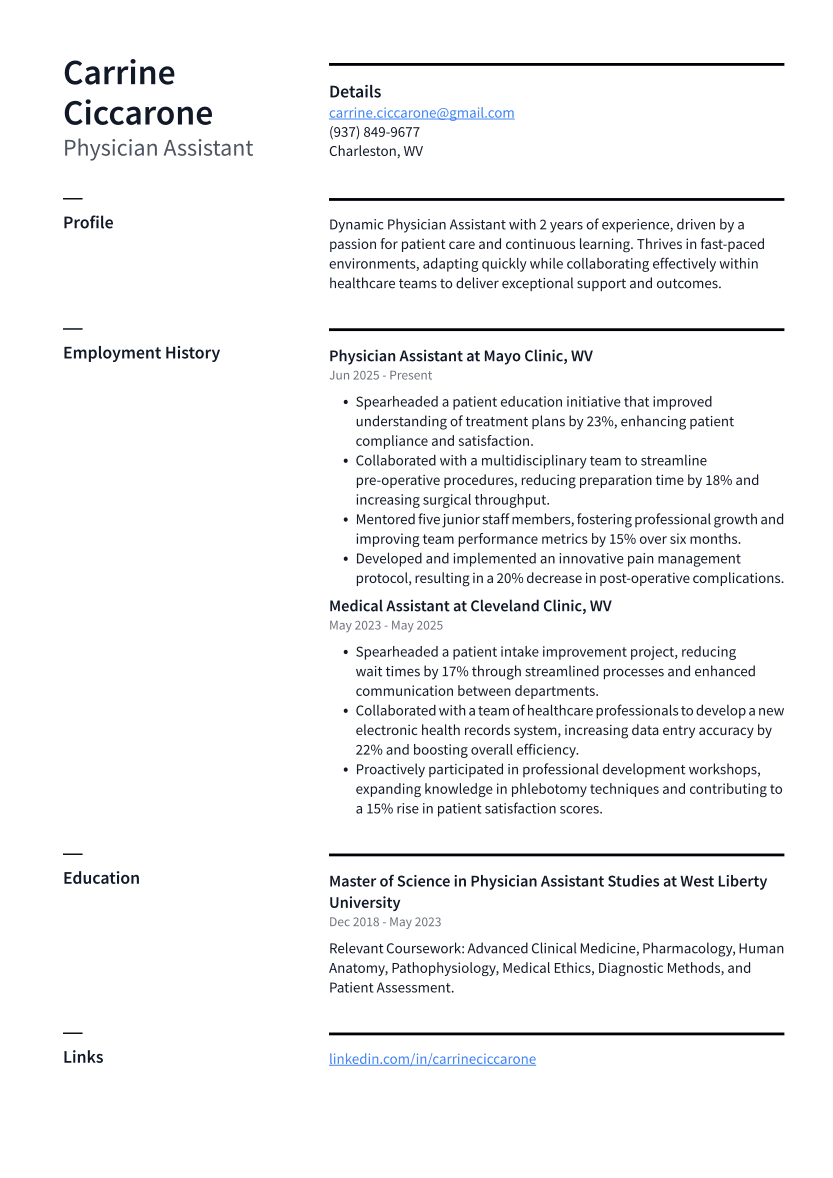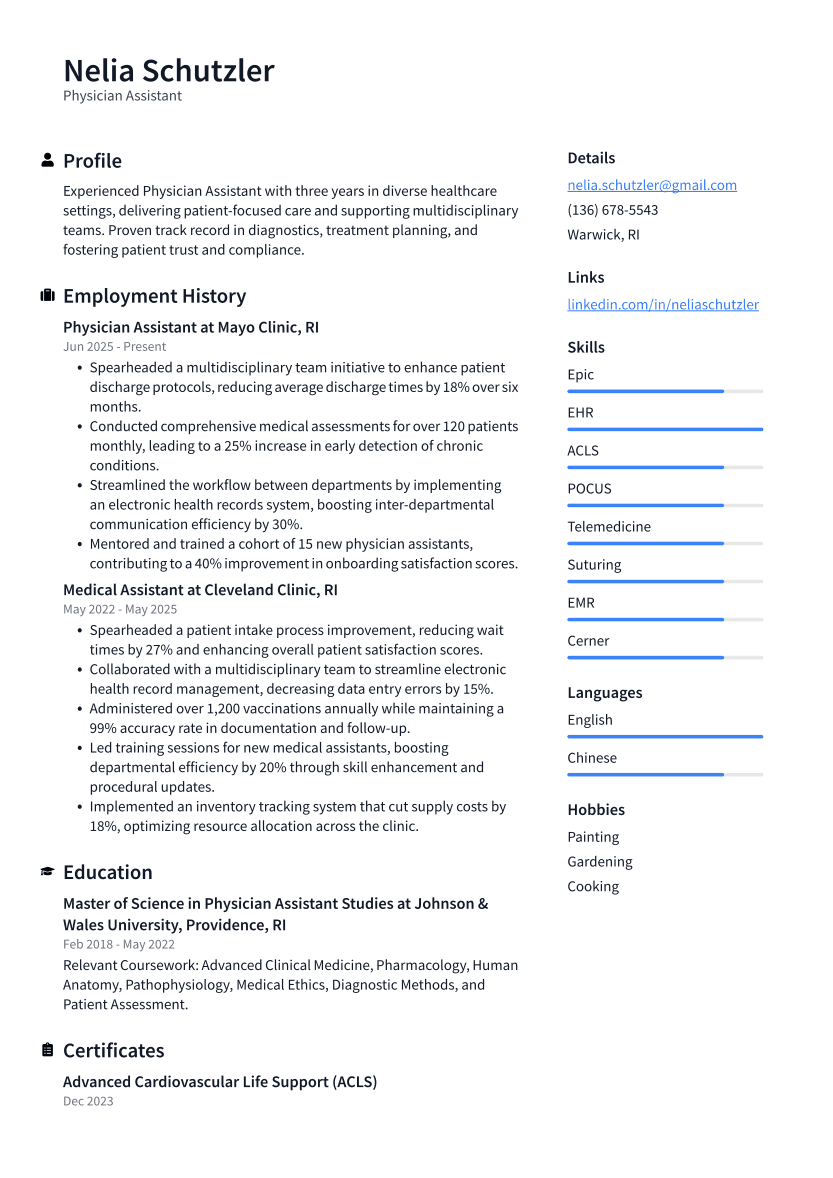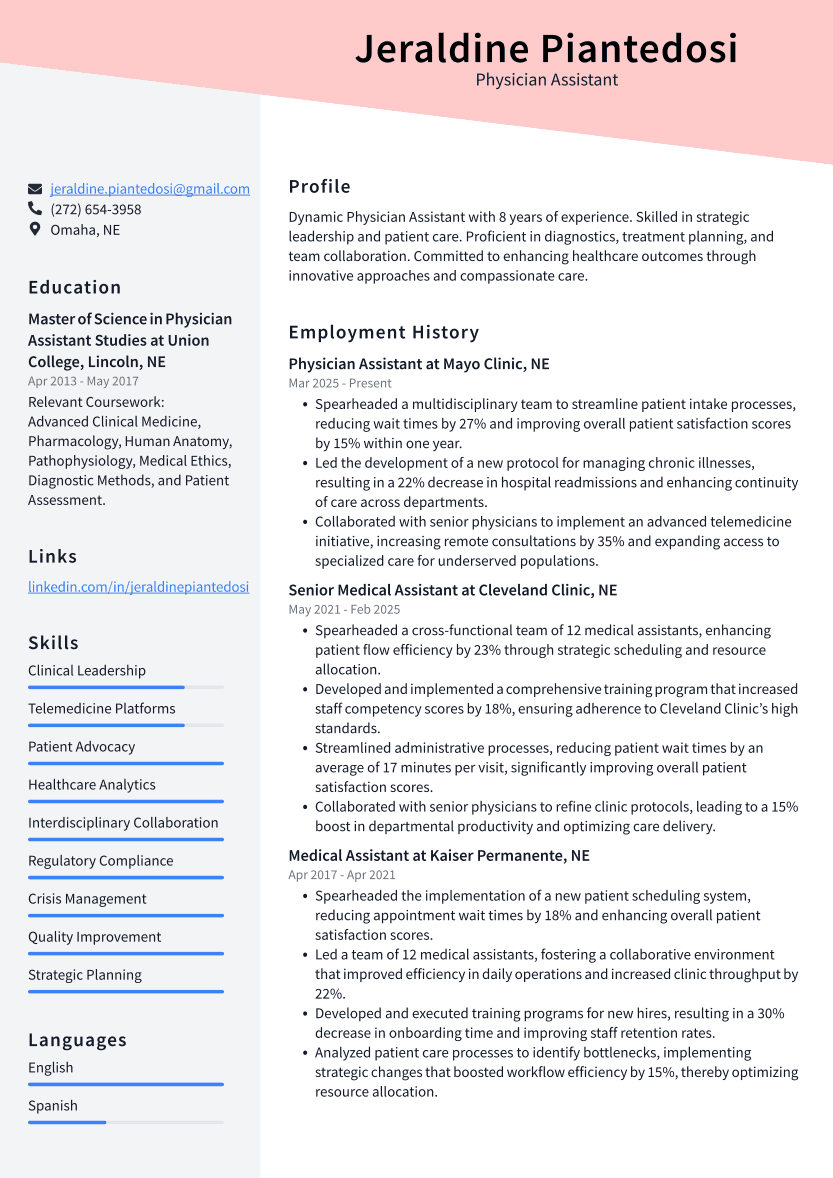Physician Assistant Resume Examples

Crafting an effective resume for a Physician Assistant position is like donning a polished lab coat—it's your first impression, and it better fit just right. In this enchanting world of medical magic, this piece will unveil the secrets to mastering resume alchemy, teaching readers how to conjure a document that captures their skills, experience, and that extra sprinkle of physician assistant pizzazz. Ready to turn your career aspirations into reality? Let's proceed.
What to Include on a Physician Assistant Resume
- Contact Information: Phone, email, and professional address.
- Summary: Brief overview of qualifications and career goals.
- Work Experience: Past roles and responsibilities in healthcare.
- Skills: Key abilities relevant to medical practice.
- Education: Degrees and certifications obtained.
- Licenses and Certifications: Required credentials for practice.
- Professional Affiliations: Memberships in medical organizations.
- Volunteer Experience: Unpaid work contributing to community health.
- Research and Publications: Studies and articles authored.
- Languages: Additional languages spoken fluently.
To tailor your resume for a Physician Assistant role, emphasize your clinical experience and patient care skills, ensuring to highlight any specialized medical procedures you've mastered. In your cover letter, illustrate your ability to collaborate with healthcare teams by sharing specific examples of successful patient outcomes or innovative problem-solving in high-pressure situations.
Pro Tip: In the tangled web of job applications, weaving relevant skills and keywords into a Physician Assistant resume is crucial, as it serves as the golden thread that guides ATS bots to your qualifications, ensuring your expertise doesn't sink into the digital abyss.
Make Your Physician Assistant Resume Shine
Showcase your achievements by emphasizing specific patient care improvements, such as reducing wait times by 30% through streamlined triage procedures or increasing patient satisfaction scores by implementing a new follow-up protocol. Highlight any contributions to team efficiency, like spearheading a project that improved clinic workflow and boosted appointment capacity by 20%.
Clear Section Headings: Use bold and slightly larger fonts for section titles like "Education," "Experience," and "Certifications" to guide the eye smoothly. This simple separation helps hiring managers quickly locate relevant information without unnecessary searching.
Consistent Font and Spacing: Opt for a professional, easy-to-read font, such as Arial or Times New Roman, and maintain consistent spacing between lines and sections. This uniformity creates a clean look and prevents the document from feeling cluttered or overwhelming.
Bullet Points for Duties and Achievements: Instead of lengthy paragraphs, use concise bullet points to outline responsibilities and accomplishments. This format highlights key details quickly and effectively, making it easier for the reader to absorb critical information at a glance.
Pro Tip: Tailoring your resume for each application highlights the most relevant skills and experiences, making you a standout candidate for the specific role.
Sample Resume for Entry-Level Physician Assistant
An entry-level Physician Assistant resume emphasizes education and clinical rotations, whereas mid-level or senior resumes highlight specialized experience and leadership roles.
Experienced Physician Assistant Resume Sample
A mid-level Physician Assistant resume highlights developing expertise and specialized skills, bridging initial experiences and advanced leadership without yet having reached senior management roles.
Sample Resume for Senior Physician Assistant
A senior-level Physician Assistant resume showcases extensive clinical expertise, leadership roles, and a history of impactful contributions, setting it apart from the more skill-focused entry-level or mid-level resumes.
Do’s, Don’ts & a Handy Checklist: Physician Assistant Resume Guide
DO'S
- Showcase clinical experience with specific roles and responsibilities.
- Highlight any specialized skills or certifications relevant to the PA field.
- Include instances where you improved patient outcomes or contributed to team effectiveness.
DON'TS
- Don’t overload it with medical jargon that confuses rather than clarifies.
- Don’t ignore quantifiable achievements; highlight outcomes instead of duties.
- Don’t use vague language like “helped” or “assisted,” which lacks impact and specificity.
CHECKLIST
- Emphasize relevant clinical experience.
- Highlight specific achievements with data.
- Tailor the resume to the job description.
- Avoid vague language or jargon.
- Do not include unnecessary personal information.
- Refrain from using an overly complex format.






